Construction Management Report: Extension to Heritage Listed House
VerifiedAdded on 2023/06/11
|17
|2901
|119
Report
AI Summary
This construction management report details the process of a two-story extension to a heritage-listed house in Melbourne. It begins by outlining the necessary permits, including planning, heritage, and building permits, and emphasizes the importance of an occupancy permit upon completion. A comprehensive Environmental Management Plan (EMP) is presented, addressing water, air quality, waste, energy, noise, traffic, biodiversity, heritage, erosion, sediment, and human health and safety management. The report further discusses site layout optimization for efficiency, safety, and security, considering factors like available space, access, existing structures, and welfare facilities. A waste management plan is also included, focusing on reduction, reuse, recycling, composting, energy recovery, and proper disposal. Stakeholder analysis identifies key participants, such as the client, contractor, project team, government agencies, subcontractors, and the local community, and their interrelationships. Finally, a construction time program is provided, estimating the project duration to be six months, from June to November 2018.
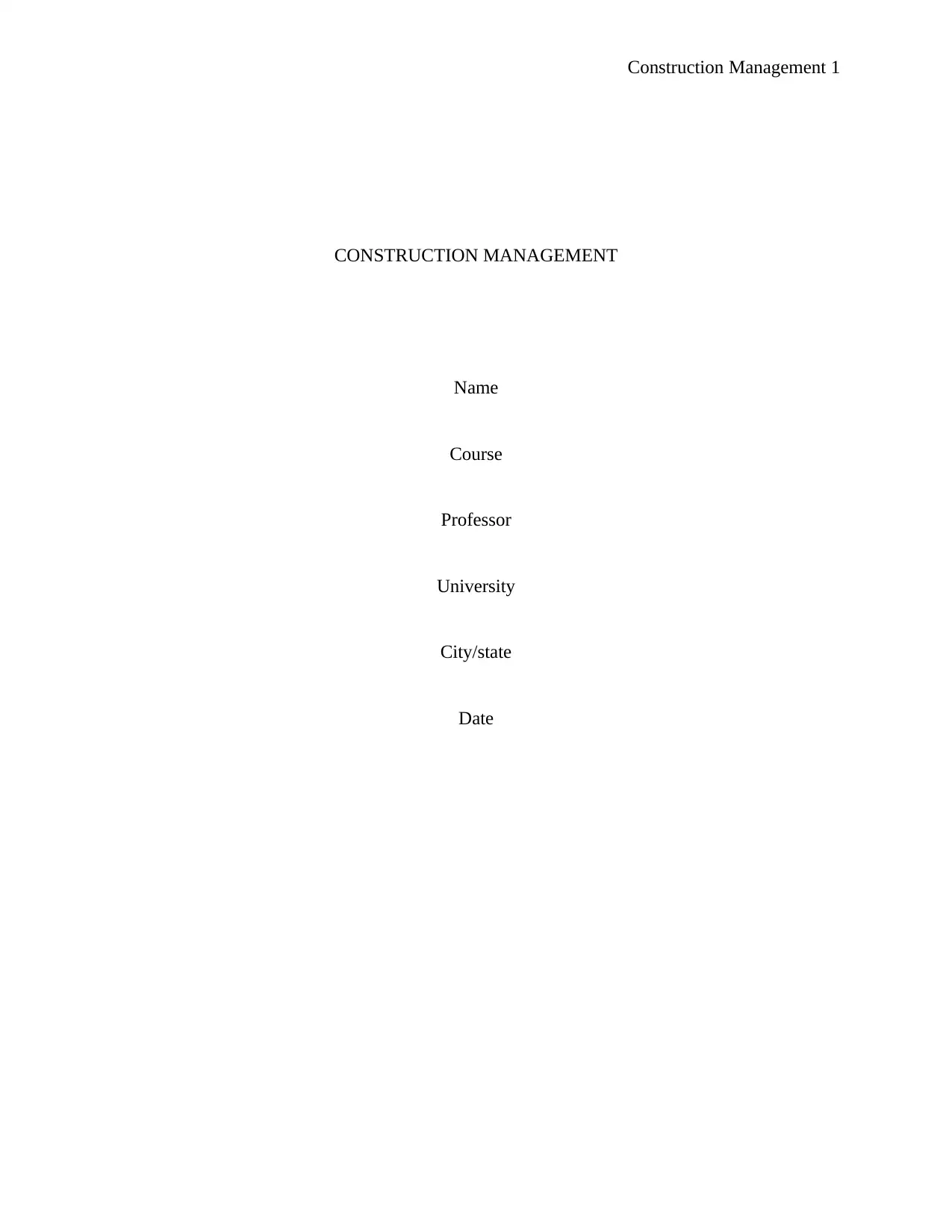
Construction Management 1
CONSTRUCTION MANAGEMENT
Name
Course
Professor
University
City/state
Date
CONSTRUCTION MANAGEMENT
Name
Course
Professor
University
City/state
Date
Paraphrase This Document
Need a fresh take? Get an instant paraphrase of this document with our AI Paraphraser
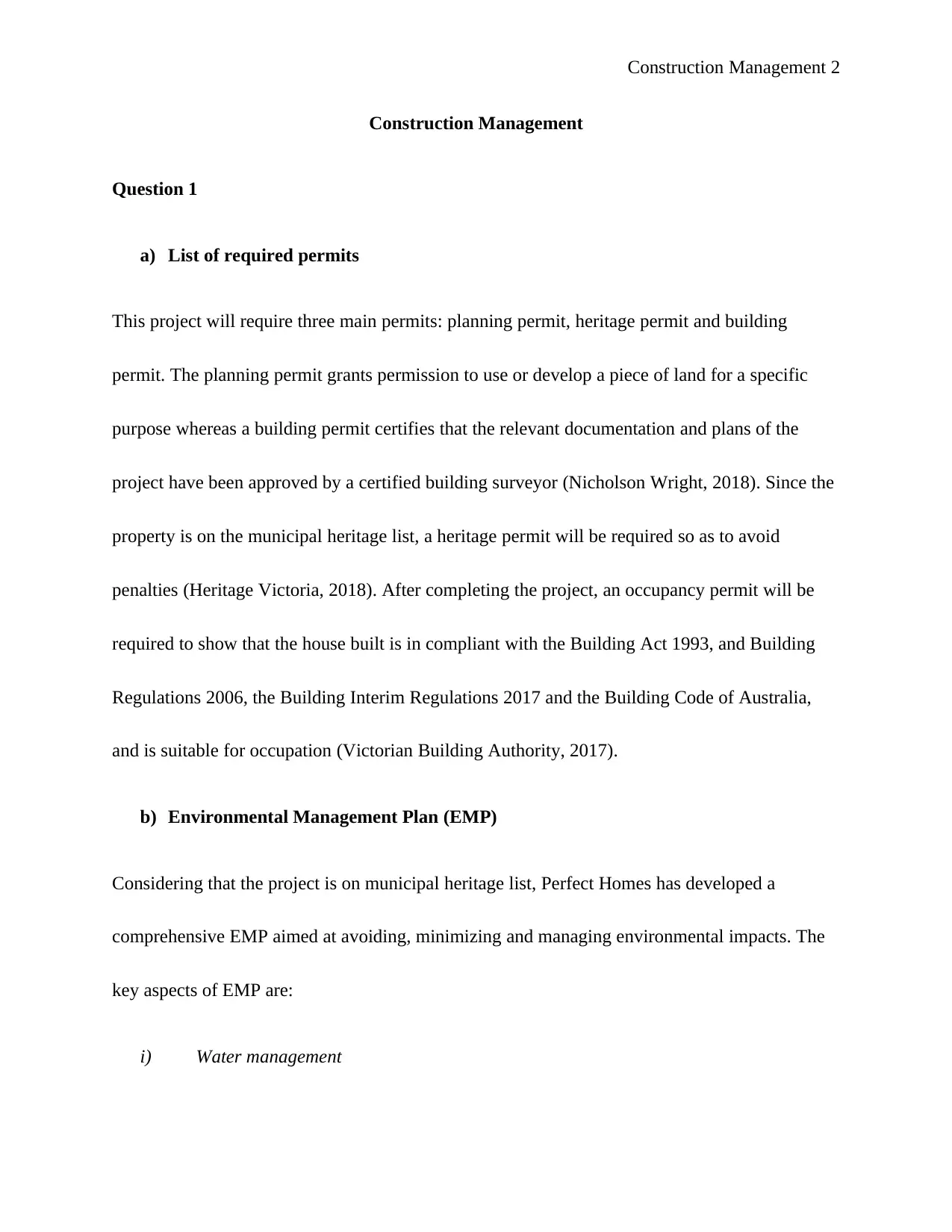
Construction Management 2
Construction Management
Question 1
a) List of required permits
This project will require three main permits: planning permit, heritage permit and building
permit. The planning permit grants permission to use or develop a piece of land for a specific
purpose whereas a building permit certifies that the relevant documentation and plans of the
project have been approved by a certified building surveyor (Nicholson Wright, 2018). Since the
property is on the municipal heritage list, a heritage permit will be required so as to avoid
penalties (Heritage Victoria, 2018). After completing the project, an occupancy permit will be
required to show that the house built is in compliant with the Building Act 1993, and Building
Regulations 2006, the Building Interim Regulations 2017 and the Building Code of Australia,
and is suitable for occupation (Victorian Building Authority, 2017).
b) Environmental Management Plan (EMP)
Considering that the project is on municipal heritage list, Perfect Homes has developed a
comprehensive EMP aimed at avoiding, minimizing and managing environmental impacts. The
key aspects of EMP are:
i) Water management
Construction Management
Question 1
a) List of required permits
This project will require three main permits: planning permit, heritage permit and building
permit. The planning permit grants permission to use or develop a piece of land for a specific
purpose whereas a building permit certifies that the relevant documentation and plans of the
project have been approved by a certified building surveyor (Nicholson Wright, 2018). Since the
property is on the municipal heritage list, a heritage permit will be required so as to avoid
penalties (Heritage Victoria, 2018). After completing the project, an occupancy permit will be
required to show that the house built is in compliant with the Building Act 1993, and Building
Regulations 2006, the Building Interim Regulations 2017 and the Building Code of Australia,
and is suitable for occupation (Victorian Building Authority, 2017).
b) Environmental Management Plan (EMP)
Considering that the project is on municipal heritage list, Perfect Homes has developed a
comprehensive EMP aimed at avoiding, minimizing and managing environmental impacts. The
key aspects of EMP are:
i) Water management
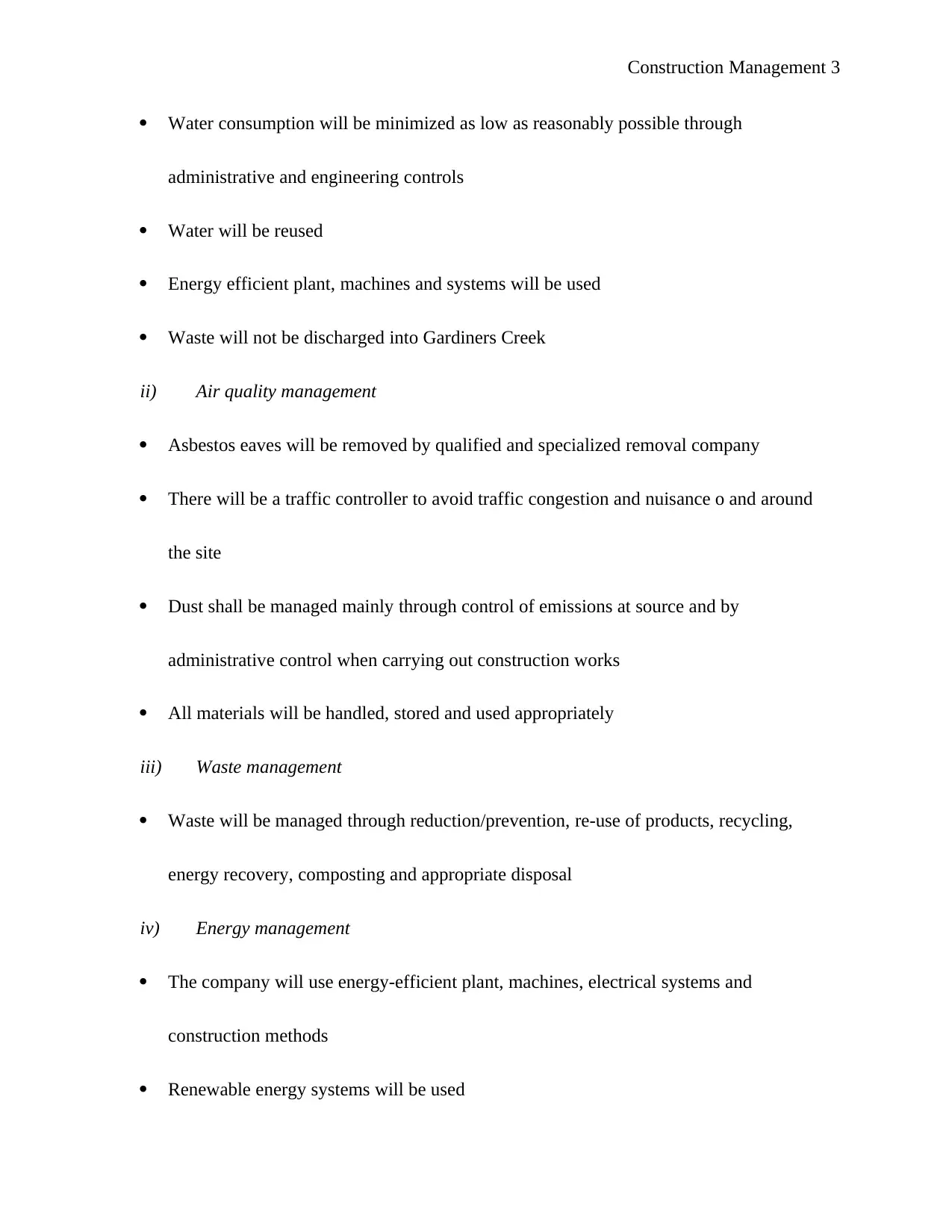
Construction Management 3
Water consumption will be minimized as low as reasonably possible through
administrative and engineering controls
Water will be reused
Energy efficient plant, machines and systems will be used
Waste will not be discharged into Gardiners Creek
ii) Air quality management
Asbestos eaves will be removed by qualified and specialized removal company
There will be a traffic controller to avoid traffic congestion and nuisance o and around
the site
Dust shall be managed mainly through control of emissions at source and by
administrative control when carrying out construction works
All materials will be handled, stored and used appropriately
iii) Waste management
Waste will be managed through reduction/prevention, re-use of products, recycling,
energy recovery, composting and appropriate disposal
iv) Energy management
The company will use energy-efficient plant, machines, electrical systems and
construction methods
Renewable energy systems will be used
Water consumption will be minimized as low as reasonably possible through
administrative and engineering controls
Water will be reused
Energy efficient plant, machines and systems will be used
Waste will not be discharged into Gardiners Creek
ii) Air quality management
Asbestos eaves will be removed by qualified and specialized removal company
There will be a traffic controller to avoid traffic congestion and nuisance o and around
the site
Dust shall be managed mainly through control of emissions at source and by
administrative control when carrying out construction works
All materials will be handled, stored and used appropriately
iii) Waste management
Waste will be managed through reduction/prevention, re-use of products, recycling,
energy recovery, composting and appropriate disposal
iv) Energy management
The company will use energy-efficient plant, machines, electrical systems and
construction methods
Renewable energy systems will be used
⊘ This is a preview!⊘
Do you want full access?
Subscribe today to unlock all pages.

Trusted by 1+ million students worldwide
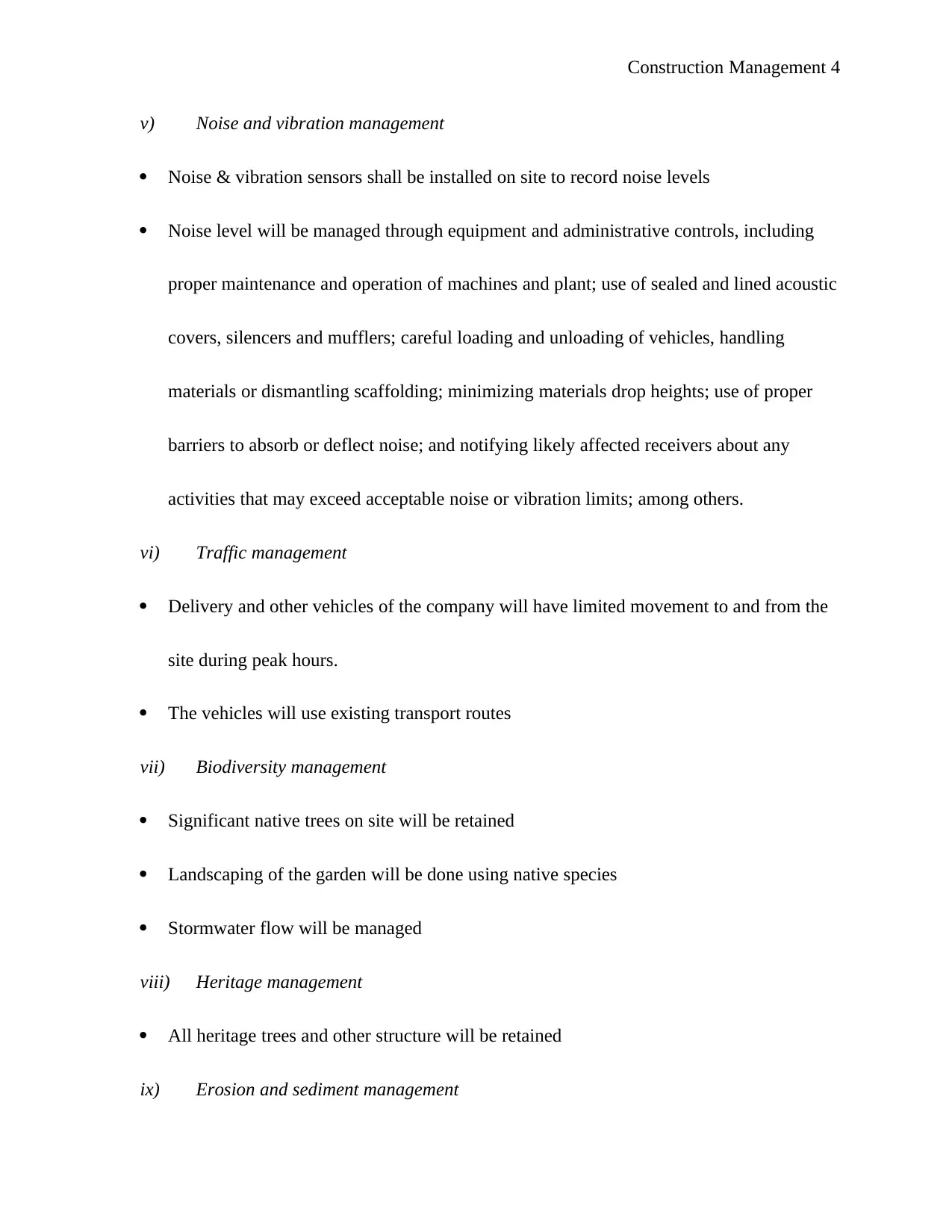
Construction Management 4
v) Noise and vibration management
Noise & vibration sensors shall be installed on site to record noise levels
Noise level will be managed through equipment and administrative controls, including
proper maintenance and operation of machines and plant; use of sealed and lined acoustic
covers, silencers and mufflers; careful loading and unloading of vehicles, handling
materials or dismantling scaffolding; minimizing materials drop heights; use of proper
barriers to absorb or deflect noise; and notifying likely affected receivers about any
activities that may exceed acceptable noise or vibration limits; among others.
vi) Traffic management
Delivery and other vehicles of the company will have limited movement to and from the
site during peak hours.
The vehicles will use existing transport routes
vii) Biodiversity management
Significant native trees on site will be retained
Landscaping of the garden will be done using native species
Stormwater flow will be managed
viii) Heritage management
All heritage trees and other structure will be retained
ix) Erosion and sediment management
v) Noise and vibration management
Noise & vibration sensors shall be installed on site to record noise levels
Noise level will be managed through equipment and administrative controls, including
proper maintenance and operation of machines and plant; use of sealed and lined acoustic
covers, silencers and mufflers; careful loading and unloading of vehicles, handling
materials or dismantling scaffolding; minimizing materials drop heights; use of proper
barriers to absorb or deflect noise; and notifying likely affected receivers about any
activities that may exceed acceptable noise or vibration limits; among others.
vi) Traffic management
Delivery and other vehicles of the company will have limited movement to and from the
site during peak hours.
The vehicles will use existing transport routes
vii) Biodiversity management
Significant native trees on site will be retained
Landscaping of the garden will be done using native species
Stormwater flow will be managed
viii) Heritage management
All heritage trees and other structure will be retained
ix) Erosion and sediment management
Paraphrase This Document
Need a fresh take? Get an instant paraphrase of this document with our AI Paraphraser
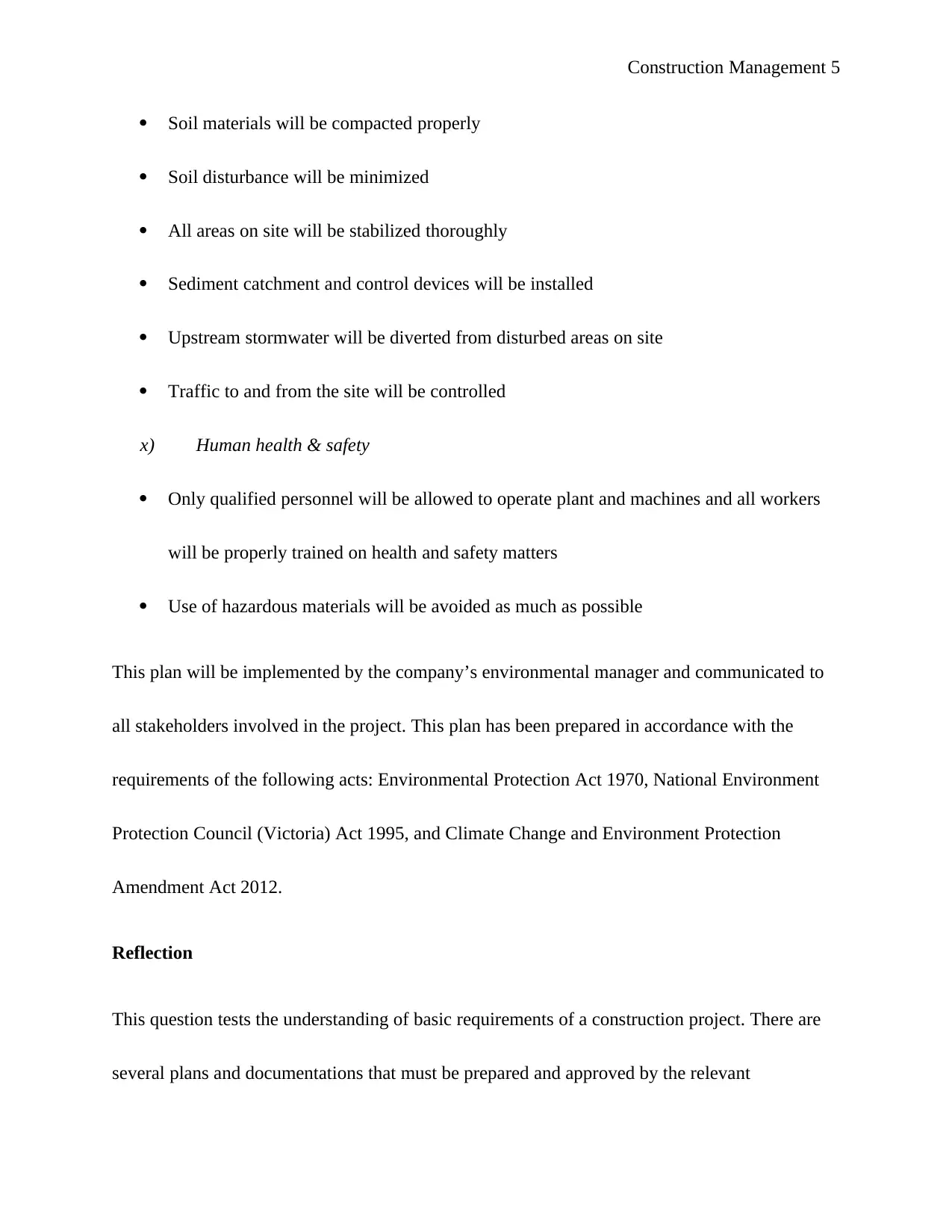
Construction Management 5
Soil materials will be compacted properly
Soil disturbance will be minimized
All areas on site will be stabilized thoroughly
Sediment catchment and control devices will be installed
Upstream stormwater will be diverted from disturbed areas on site
Traffic to and from the site will be controlled
x) Human health & safety
Only qualified personnel will be allowed to operate plant and machines and all workers
will be properly trained on health and safety matters
Use of hazardous materials will be avoided as much as possible
This plan will be implemented by the company’s environmental manager and communicated to
all stakeholders involved in the project. This plan has been prepared in accordance with the
requirements of the following acts: Environmental Protection Act 1970, National Environment
Protection Council (Victoria) Act 1995, and Climate Change and Environment Protection
Amendment Act 2012.
Reflection
This question tests the understanding of basic requirements of a construction project. There are
several plans and documentations that must be prepared and approved by the relevant
Soil materials will be compacted properly
Soil disturbance will be minimized
All areas on site will be stabilized thoroughly
Sediment catchment and control devices will be installed
Upstream stormwater will be diverted from disturbed areas on site
Traffic to and from the site will be controlled
x) Human health & safety
Only qualified personnel will be allowed to operate plant and machines and all workers
will be properly trained on health and safety matters
Use of hazardous materials will be avoided as much as possible
This plan will be implemented by the company’s environmental manager and communicated to
all stakeholders involved in the project. This plan has been prepared in accordance with the
requirements of the following acts: Environmental Protection Act 1970, National Environment
Protection Council (Victoria) Act 1995, and Climate Change and Environment Protection
Amendment Act 2012.
Reflection
This question tests the understanding of basic requirements of a construction project. There are
several plans and documentations that must be prepared and approved by the relevant
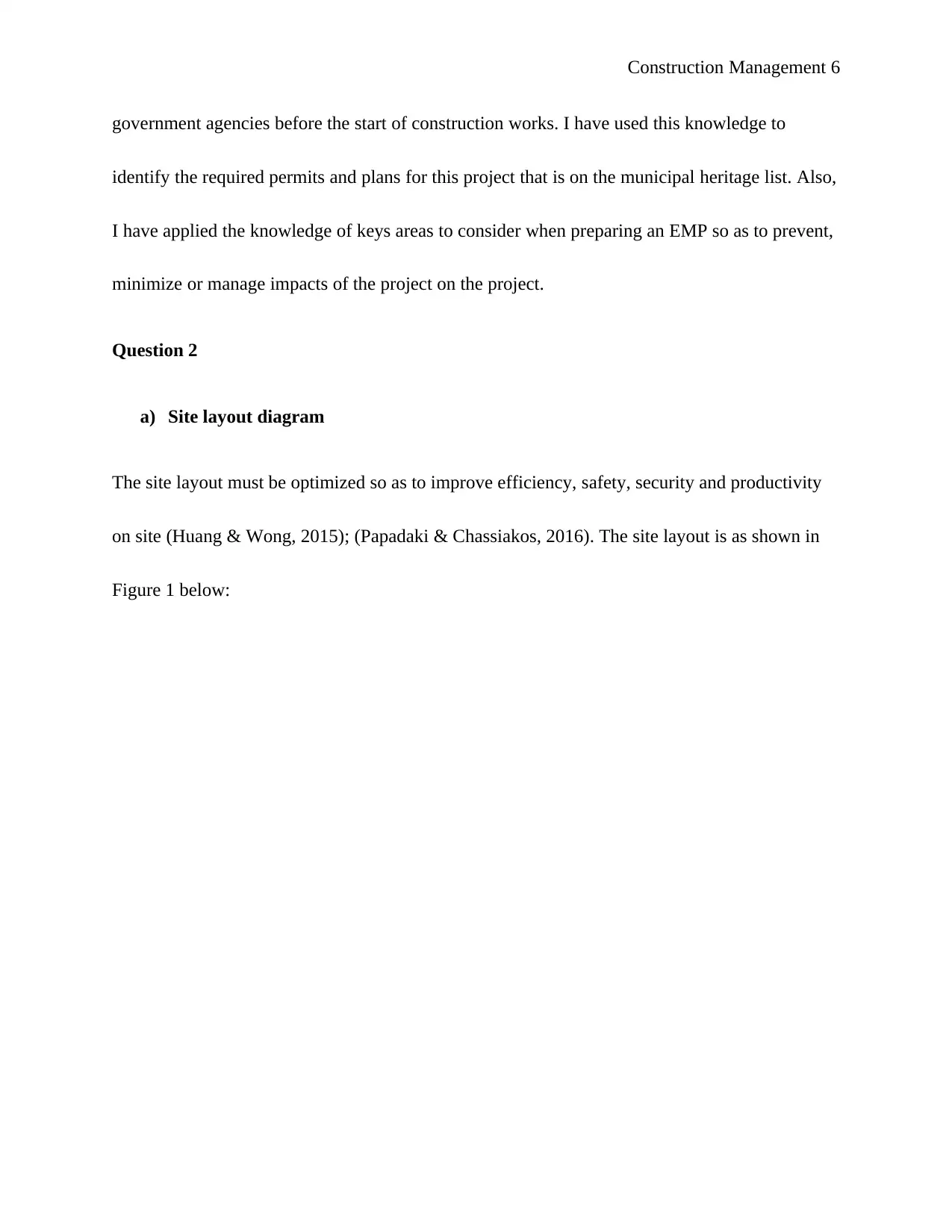
Construction Management 6
government agencies before the start of construction works. I have used this knowledge to
identify the required permits and plans for this project that is on the municipal heritage list. Also,
I have applied the knowledge of keys areas to consider when preparing an EMP so as to prevent,
minimize or manage impacts of the project on the project.
Question 2
a) Site layout diagram
The site layout must be optimized so as to improve efficiency, safety, security and productivity
on site (Huang & Wong, 2015); (Papadaki & Chassiakos, 2016). The site layout is as shown in
Figure 1 below:
government agencies before the start of construction works. I have used this knowledge to
identify the required permits and plans for this project that is on the municipal heritage list. Also,
I have applied the knowledge of keys areas to consider when preparing an EMP so as to prevent,
minimize or manage impacts of the project on the project.
Question 2
a) Site layout diagram
The site layout must be optimized so as to improve efficiency, safety, security and productivity
on site (Huang & Wong, 2015); (Papadaki & Chassiakos, 2016). The site layout is as shown in
Figure 1 below:
⊘ This is a preview!⊘
Do you want full access?
Subscribe today to unlock all pages.

Trusted by 1+ million students worldwide
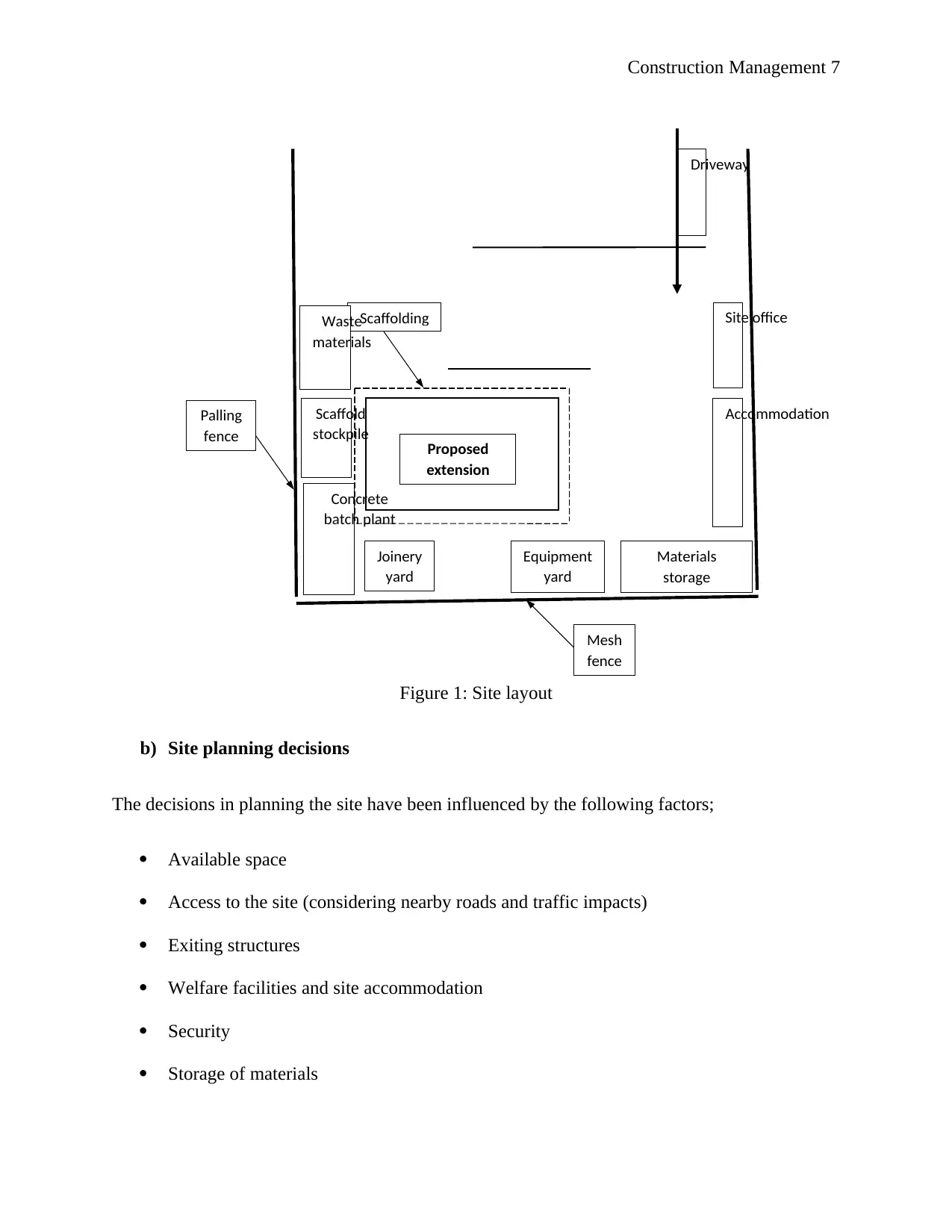
Construction Management 7
Figure 1: Site layout
b) Site planning decisions
The decisions in planning the site have been influenced by the following factors;
Available space
Access to the site (considering nearby roads and traffic impacts)
Exiting structures
Welfare facilities and site accommodation
Security
Storage of materials
Materials
storage
Concrete
batch plant
Equipment
yard
storage
Scaffold
stockpile
Joinery
yard
Accommodation
Site office
Driveway
Proposed
extension
ScaffoldingWaste
materials
Palling
fence
Mesh
fence
Figure 1: Site layout
b) Site planning decisions
The decisions in planning the site have been influenced by the following factors;
Available space
Access to the site (considering nearby roads and traffic impacts)
Exiting structures
Welfare facilities and site accommodation
Security
Storage of materials
Materials
storage
Concrete
batch plant
Equipment
yard
storage
Scaffold
stockpile
Joinery
yard
Accommodation
Site office
Driveway
Proposed
extension
ScaffoldingWaste
materials
Palling
fence
Mesh
fence
Paraphrase This Document
Need a fresh take? Get an instant paraphrase of this document with our AI Paraphraser
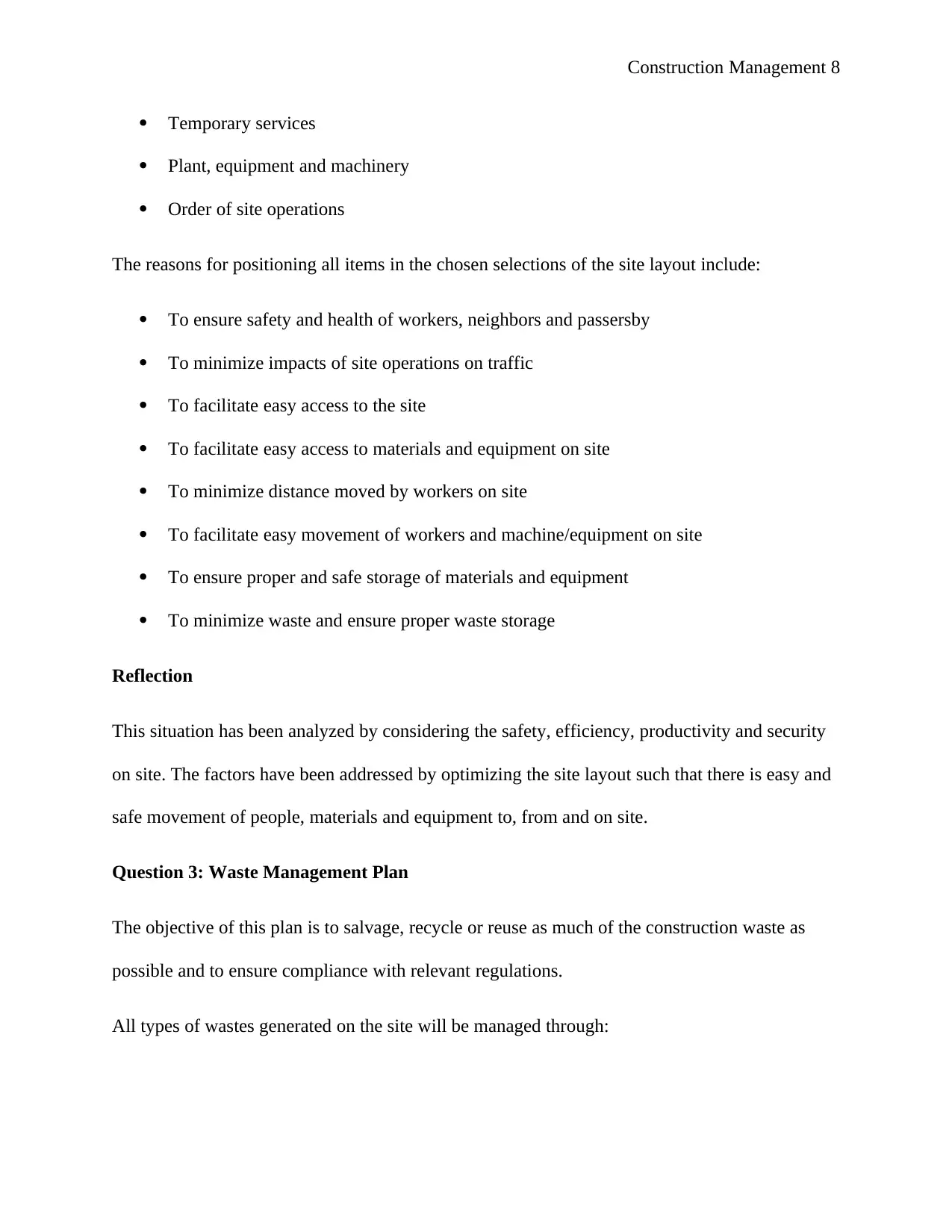
Construction Management 8
Temporary services
Plant, equipment and machinery
Order of site operations
The reasons for positioning all items in the chosen selections of the site layout include:
To ensure safety and health of workers, neighbors and passersby
To minimize impacts of site operations on traffic
To facilitate easy access to the site
To facilitate easy access to materials and equipment on site
To minimize distance moved by workers on site
To facilitate easy movement of workers and machine/equipment on site
To ensure proper and safe storage of materials and equipment
To minimize waste and ensure proper waste storage
Reflection
This situation has been analyzed by considering the safety, efficiency, productivity and security
on site. The factors have been addressed by optimizing the site layout such that there is easy and
safe movement of people, materials and equipment to, from and on site.
Question 3: Waste Management Plan
The objective of this plan is to salvage, recycle or reuse as much of the construction waste as
possible and to ensure compliance with relevant regulations.
All types of wastes generated on the site will be managed through:
Temporary services
Plant, equipment and machinery
Order of site operations
The reasons for positioning all items in the chosen selections of the site layout include:
To ensure safety and health of workers, neighbors and passersby
To minimize impacts of site operations on traffic
To facilitate easy access to the site
To facilitate easy access to materials and equipment on site
To minimize distance moved by workers on site
To facilitate easy movement of workers and machine/equipment on site
To ensure proper and safe storage of materials and equipment
To minimize waste and ensure proper waste storage
Reflection
This situation has been analyzed by considering the safety, efficiency, productivity and security
on site. The factors have been addressed by optimizing the site layout such that there is easy and
safe movement of people, materials and equipment to, from and on site.
Question 3: Waste Management Plan
The objective of this plan is to salvage, recycle or reuse as much of the construction waste as
possible and to ensure compliance with relevant regulations.
All types of wastes generated on the site will be managed through:
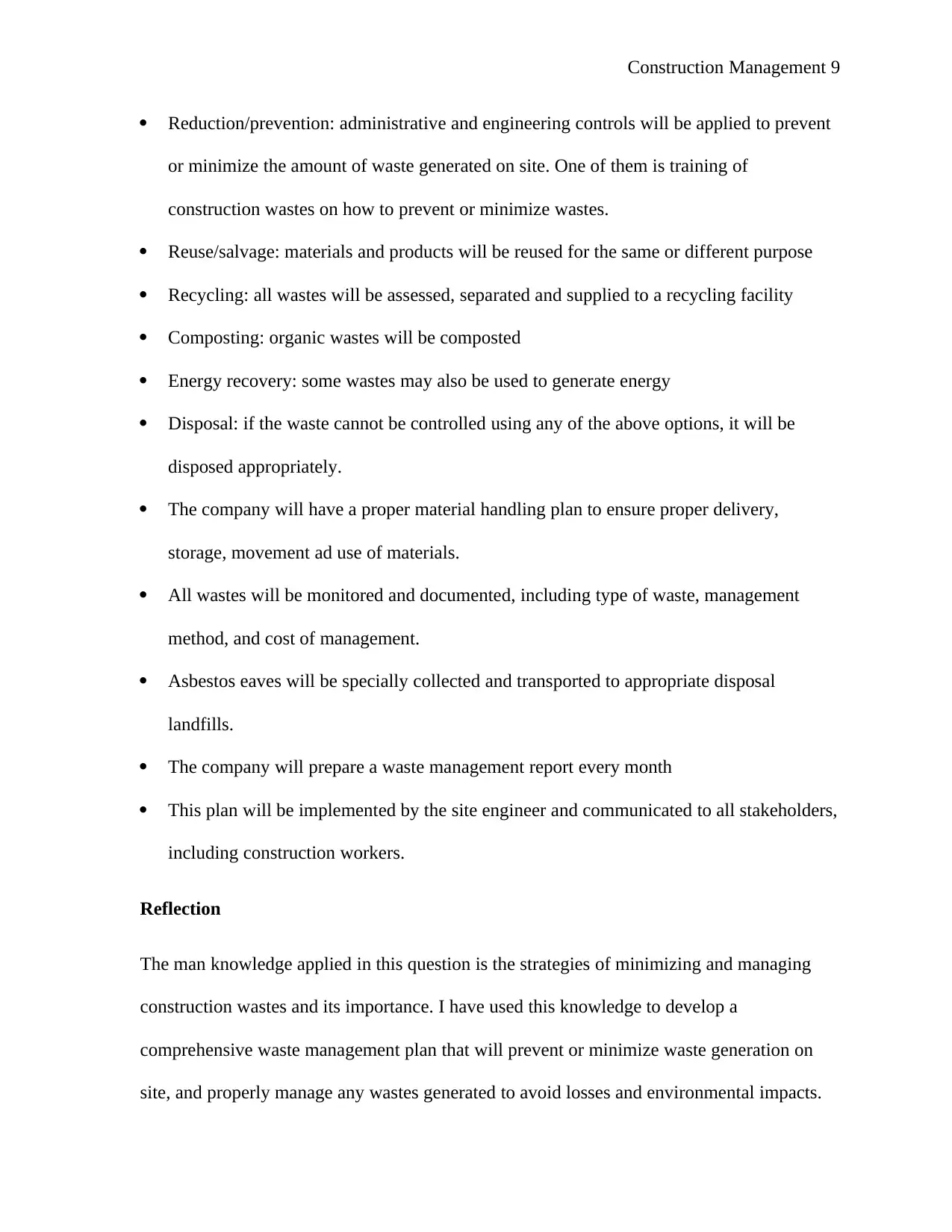
Construction Management 9
Reduction/prevention: administrative and engineering controls will be applied to prevent
or minimize the amount of waste generated on site. One of them is training of
construction wastes on how to prevent or minimize wastes.
Reuse/salvage: materials and products will be reused for the same or different purpose
Recycling: all wastes will be assessed, separated and supplied to a recycling facility
Composting: organic wastes will be composted
Energy recovery: some wastes may also be used to generate energy
Disposal: if the waste cannot be controlled using any of the above options, it will be
disposed appropriately.
The company will have a proper material handling plan to ensure proper delivery,
storage, movement ad use of materials.
All wastes will be monitored and documented, including type of waste, management
method, and cost of management.
Asbestos eaves will be specially collected and transported to appropriate disposal
landfills.
The company will prepare a waste management report every month
This plan will be implemented by the site engineer and communicated to all stakeholders,
including construction workers.
Reflection
The man knowledge applied in this question is the strategies of minimizing and managing
construction wastes and its importance. I have used this knowledge to develop a
comprehensive waste management plan that will prevent or minimize waste generation on
site, and properly manage any wastes generated to avoid losses and environmental impacts.
Reduction/prevention: administrative and engineering controls will be applied to prevent
or minimize the amount of waste generated on site. One of them is training of
construction wastes on how to prevent or minimize wastes.
Reuse/salvage: materials and products will be reused for the same or different purpose
Recycling: all wastes will be assessed, separated and supplied to a recycling facility
Composting: organic wastes will be composted
Energy recovery: some wastes may also be used to generate energy
Disposal: if the waste cannot be controlled using any of the above options, it will be
disposed appropriately.
The company will have a proper material handling plan to ensure proper delivery,
storage, movement ad use of materials.
All wastes will be monitored and documented, including type of waste, management
method, and cost of management.
Asbestos eaves will be specially collected and transported to appropriate disposal
landfills.
The company will prepare a waste management report every month
This plan will be implemented by the site engineer and communicated to all stakeholders,
including construction workers.
Reflection
The man knowledge applied in this question is the strategies of minimizing and managing
construction wastes and its importance. I have used this knowledge to develop a
comprehensive waste management plan that will prevent or minimize waste generation on
site, and properly manage any wastes generated to avoid losses and environmental impacts.
⊘ This is a preview!⊘
Do you want full access?
Subscribe today to unlock all pages.

Trusted by 1+ million students worldwide
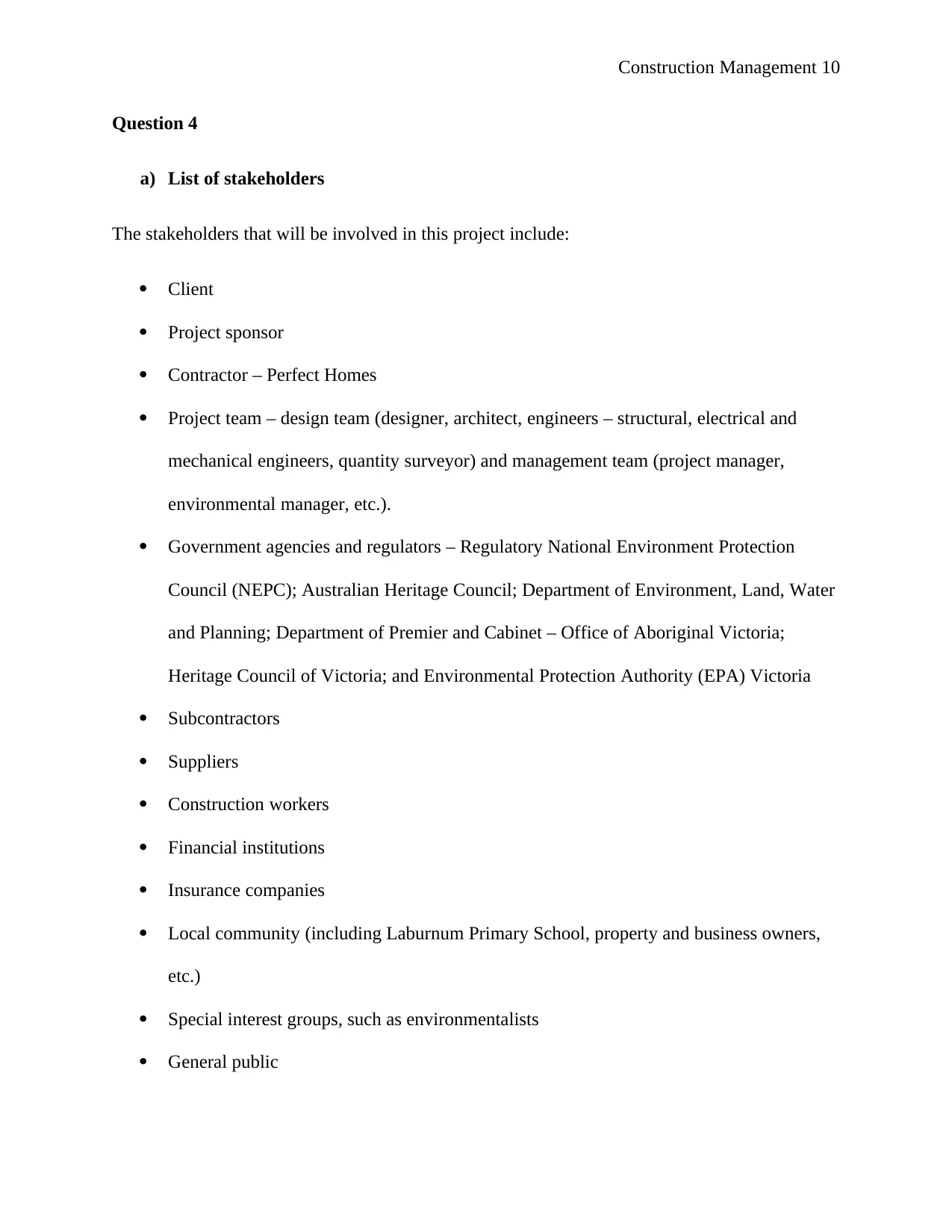
Construction Management 10
Question 4
a) List of stakeholders
The stakeholders that will be involved in this project include:
Client
Project sponsor
Contractor – Perfect Homes
Project team – design team (designer, architect, engineers – structural, electrical and
mechanical engineers, quantity surveyor) and management team (project manager,
environmental manager, etc.).
Government agencies and regulators – Regulatory National Environment Protection
Council (NEPC); Australian Heritage Council; Department of Environment, Land, Water
and Planning; Department of Premier and Cabinet – Office of Aboriginal Victoria;
Heritage Council of Victoria; and Environmental Protection Authority (EPA) Victoria
Subcontractors
Suppliers
Construction workers
Financial institutions
Insurance companies
Local community (including Laburnum Primary School, property and business owners,
etc.)
Special interest groups, such as environmentalists
General public
Question 4
a) List of stakeholders
The stakeholders that will be involved in this project include:
Client
Project sponsor
Contractor – Perfect Homes
Project team – design team (designer, architect, engineers – structural, electrical and
mechanical engineers, quantity surveyor) and management team (project manager,
environmental manager, etc.).
Government agencies and regulators – Regulatory National Environment Protection
Council (NEPC); Australian Heritage Council; Department of Environment, Land, Water
and Planning; Department of Premier and Cabinet – Office of Aboriginal Victoria;
Heritage Council of Victoria; and Environmental Protection Authority (EPA) Victoria
Subcontractors
Suppliers
Construction workers
Financial institutions
Insurance companies
Local community (including Laburnum Primary School, property and business owners,
etc.)
Special interest groups, such as environmentalists
General public
Paraphrase This Document
Need a fresh take? Get an instant paraphrase of this document with our AI Paraphraser
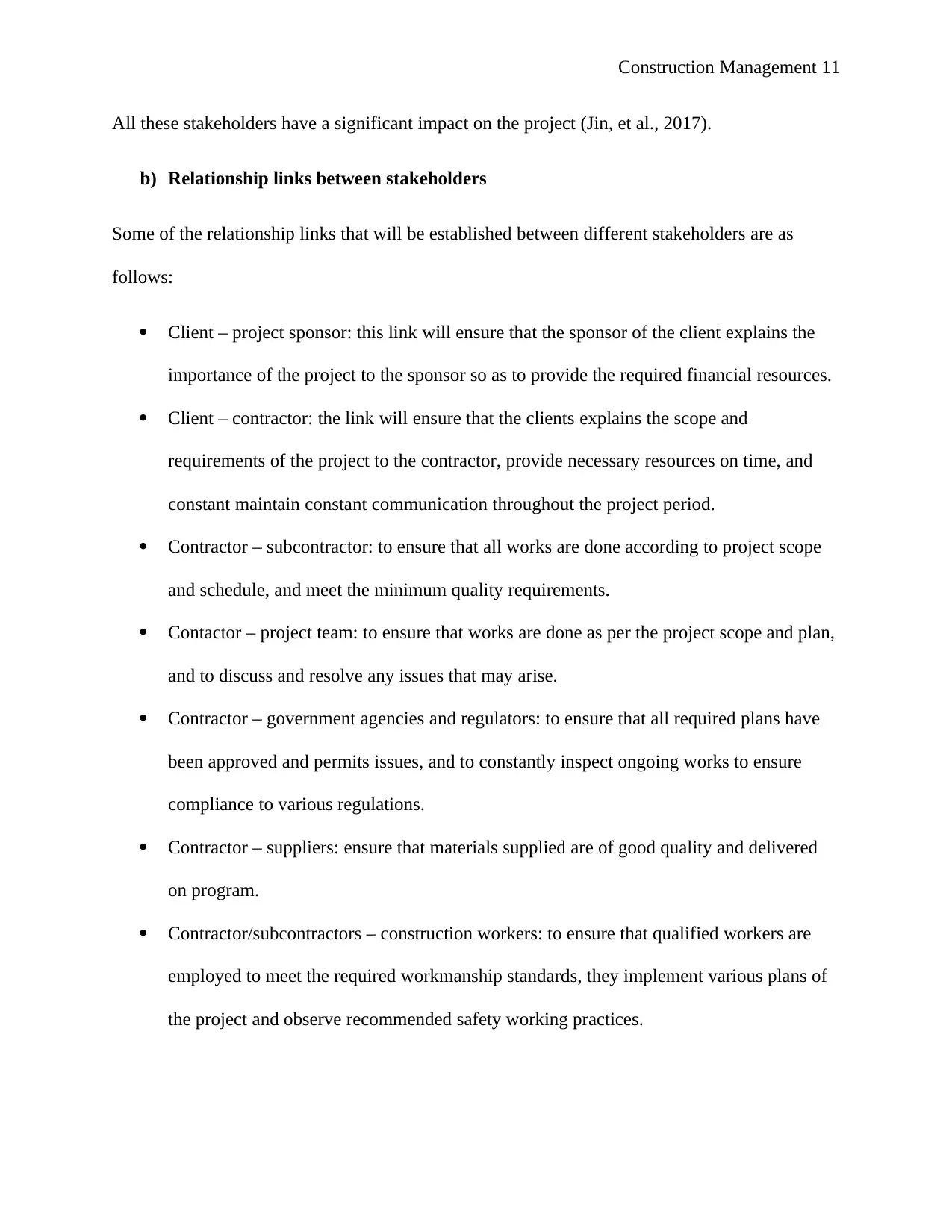
Construction Management 11
All these stakeholders have a significant impact on the project (Jin, et al., 2017).
b) Relationship links between stakeholders
Some of the relationship links that will be established between different stakeholders are as
follows:
Client – project sponsor: this link will ensure that the sponsor of the client explains the
importance of the project to the sponsor so as to provide the required financial resources.
Client – contractor: the link will ensure that the clients explains the scope and
requirements of the project to the contractor, provide necessary resources on time, and
constant maintain constant communication throughout the project period.
Contractor – subcontractor: to ensure that all works are done according to project scope
and schedule, and meet the minimum quality requirements.
Contactor – project team: to ensure that works are done as per the project scope and plan,
and to discuss and resolve any issues that may arise.
Contractor – government agencies and regulators: to ensure that all required plans have
been approved and permits issues, and to constantly inspect ongoing works to ensure
compliance to various regulations.
Contractor – suppliers: ensure that materials supplied are of good quality and delivered
on program.
Contractor/subcontractors – construction workers: to ensure that qualified workers are
employed to meet the required workmanship standards, they implement various plans of
the project and observe recommended safety working practices.
All these stakeholders have a significant impact on the project (Jin, et al., 2017).
b) Relationship links between stakeholders
Some of the relationship links that will be established between different stakeholders are as
follows:
Client – project sponsor: this link will ensure that the sponsor of the client explains the
importance of the project to the sponsor so as to provide the required financial resources.
Client – contractor: the link will ensure that the clients explains the scope and
requirements of the project to the contractor, provide necessary resources on time, and
constant maintain constant communication throughout the project period.
Contractor – subcontractor: to ensure that all works are done according to project scope
and schedule, and meet the minimum quality requirements.
Contactor – project team: to ensure that works are done as per the project scope and plan,
and to discuss and resolve any issues that may arise.
Contractor – government agencies and regulators: to ensure that all required plans have
been approved and permits issues, and to constantly inspect ongoing works to ensure
compliance to various regulations.
Contractor – suppliers: ensure that materials supplied are of good quality and delivered
on program.
Contractor/subcontractors – construction workers: to ensure that qualified workers are
employed to meet the required workmanship standards, they implement various plans of
the project and observe recommended safety working practices.
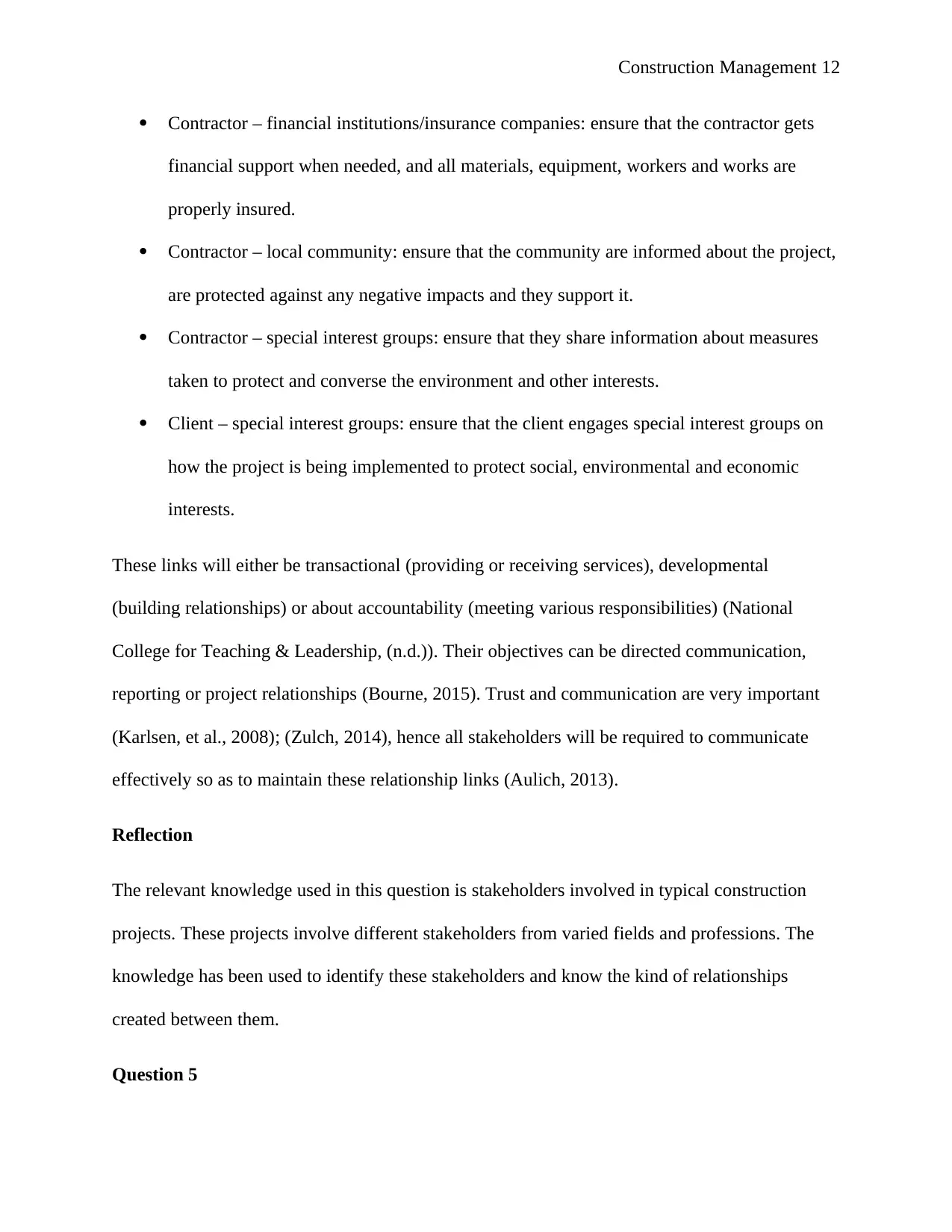
Construction Management 12
Contractor – financial institutions/insurance companies: ensure that the contractor gets
financial support when needed, and all materials, equipment, workers and works are
properly insured.
Contractor – local community: ensure that the community are informed about the project,
are protected against any negative impacts and they support it.
Contractor – special interest groups: ensure that they share information about measures
taken to protect and converse the environment and other interests.
Client – special interest groups: ensure that the client engages special interest groups on
how the project is being implemented to protect social, environmental and economic
interests.
These links will either be transactional (providing or receiving services), developmental
(building relationships) or about accountability (meeting various responsibilities) (National
College for Teaching & Leadership, (n.d.)). Their objectives can be directed communication,
reporting or project relationships (Bourne, 2015). Trust and communication are very important
(Karlsen, et al., 2008); (Zulch, 2014), hence all stakeholders will be required to communicate
effectively so as to maintain these relationship links (Aulich, 2013).
Reflection
The relevant knowledge used in this question is stakeholders involved in typical construction
projects. These projects involve different stakeholders from varied fields and professions. The
knowledge has been used to identify these stakeholders and know the kind of relationships
created between them.
Question 5
Contractor – financial institutions/insurance companies: ensure that the contractor gets
financial support when needed, and all materials, equipment, workers and works are
properly insured.
Contractor – local community: ensure that the community are informed about the project,
are protected against any negative impacts and they support it.
Contractor – special interest groups: ensure that they share information about measures
taken to protect and converse the environment and other interests.
Client – special interest groups: ensure that the client engages special interest groups on
how the project is being implemented to protect social, environmental and economic
interests.
These links will either be transactional (providing or receiving services), developmental
(building relationships) or about accountability (meeting various responsibilities) (National
College for Teaching & Leadership, (n.d.)). Their objectives can be directed communication,
reporting or project relationships (Bourne, 2015). Trust and communication are very important
(Karlsen, et al., 2008); (Zulch, 2014), hence all stakeholders will be required to communicate
effectively so as to maintain these relationship links (Aulich, 2013).
Reflection
The relevant knowledge used in this question is stakeholders involved in typical construction
projects. These projects involve different stakeholders from varied fields and professions. The
knowledge has been used to identify these stakeholders and know the kind of relationships
created between them.
Question 5
⊘ This is a preview!⊘
Do you want full access?
Subscribe today to unlock all pages.

Trusted by 1+ million students worldwide
1 out of 17
Related Documents
Your All-in-One AI-Powered Toolkit for Academic Success.
+13062052269
info@desklib.com
Available 24*7 on WhatsApp / Email
![[object Object]](/_next/static/media/star-bottom.7253800d.svg)
Unlock your academic potential
Copyright © 2020–2025 A2Z Services. All Rights Reserved. Developed and managed by ZUCOL.




![Environmental Management Plan for [Project Name] Construction Site](/_next/image/?url=https%3A%2F%2Fdesklib.com%2Fmedia%2Fimages%2Fsi%2F6823bb3e56f24aeb879abd5f44d3c47b.jpg&w=256&q=75)
